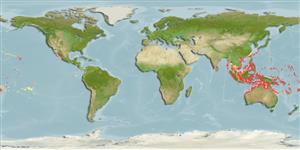Environment: milieu / climate zone / depth range / distribution range
Écologie
marin récifal; non migrateur; profondeur 20 - 45 m (Ref. 9710). Tropical; 30°N - 23°S
Western Pacific: Indonesia to Fiji, north to the Ryukyu Islands, south to Rowley Shoals in the eastern Indian Ocean and New Caledonia. Recently recorded from Tonga (Ref. 53797).
Taille / Poids / Âge
Maturity: Lm ? range ? - ? cm
Max length : 18.0 cm TL mâle / non sexé; (Ref. 9710)
Épines dorsales (Total) : 15; Rayons mous dorsaux (Total) : 15 - 17; Épines anales: 3; Rayons mous anaux: 17 - 18.
Generally seen in pairs on steep outer reef slopes, drop-offs (Ref. 9710), in caves or along the bases of boulders (Ref.48636); in rich coral growth interspersed with sand (Ref. 37816). Usually occurs in loose groups of females dominated by a male. Sometimes feeds on plankton high above the substrate (Ref.48636).
Life cycle and mating behavior
Maturité | Reproduction | Frai | Œufs | Fécondité | Larves
Steene, R.C., 1978. Butterfly and angelfishes of the world. A.H. & A.W. Reed Pty Ltd., Australia. vol. 1. 144 p. (Ref. 4859)
Statut dans la liste rouge de l'IUCN (Ref. 130435: Version 2024-1)
Menace pour l'homme
Harmless
Utilisations par l'homme
Pêcheries: sans intérêt; Aquarium: Commercial
Outils
Articles particuliers
Télécharger en XML
Sources Internet
Estimates based on models
Preferred temperature (Ref.
123201): 24.5 - 28.5, mean 27.1 °C (based on 90 cells).
Phylogenetic diversity index (Ref.
82804): PD
50 = 0.5010 [Uniqueness, from 0.5 = low to 2.0 = high].
Bayesian length-weight: a=0.03090 (0.01378 - 0.06932), b=2.88 (2.69 - 3.07), in cm total length, based on LWR estimates for this (Sub)family-body shape (Ref.
93245).
Niveau trophique (Ref.
69278): 3.4 ±0.45 se; based on food items.
Résilience (Ref.
120179): Milieu, temps minimum de doublement de population : 1,4 à 4,4 années (Preliminary K or Fecundity.).
Fishing Vulnerability (Ref.
59153): Low vulnerability (10 of 100).
Nutrients (Ref.
124155): Calcium = 70.4 [35.1, 109.1] mg/100g; Iron = 0.668 [0.402, 1.104] mg/100g; Protein = 18.3 [17.1, 19.4] %; Omega3 = 0.114 [0.068, 0.189] g/100g; Selenium = 25.5 [13.2, 50.1] μg/100g; VitaminA = 146 [41, 490] μg/100g; Zinc = 1.25 [0.83, 1.78] mg/100g (wet weight);
